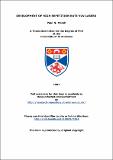Files in this item
Development of high repetition rate VUV lasers
Item metadata
| dc.contributor.advisor | Little, Chris | |
| dc.contributor.author | Marsh, Paul N. | |
| dc.coverage.spatial | 307 p. | en_US |
| dc.date.accessioned | 2015-09-02T15:08:23Z | |
| dc.date.available | 2015-09-02T15:08:23Z | |
| dc.date.issued | 1997 | |
| dc.identifier | uk.bl.ethos.536755 | |
| dc.identifier.uri | https://hdl.handle.net/10023/7394 | |
| dc.description.abstract | The work described in this thesis was aimed at developing a field of expertise in short wavelength lasers within the department of Physics and Astronomy at St. Andrews University. Electrical discharge pumping was selected as the excitation mechanism while the Lyman band of hydrogen was identified as the initial target for the vacuum ultraviolet work. Due to the short upper state lifetime of the laser transition (~0.8ns), fast voltage pulse risetimes and an accurately timed, travelling electrical excitation wave matched to the speed of light in the discharge were required. Initial work succeeded in producing voltage pulses at high repetition rates having leading edges exhibiting risetimes of under 300psec with voltage magnitudes in the 30-40kV regime. This was achieved by designing and building non-linear ferromagnetic shock lines whose purpose was to sharpen the output pulse from a thyratron having a risetime of 40-50ns. Voltage pulse risetime reductions on this magnitude have not been seen previously in the literature by this author. By the accurate timing of the outputs of ten such lines placed in parallel, the travelling electrical excitation wave could be created. Allied to work conducted simultaneously upon flat plate Blumlein driven hydrogen lasers, this culminated in the production and operation of a thyratron driven, sectional longitudinal hydrogen laser capable of high repetition rates. This is the first of its type of which this author is aware. Laser pulse energies of 4.7μJ on the 160nm Lyman band transitions were observed while the only limitation encountered in running the laser at multi-kilohertz repetition rates in burst mode was that imposed by the charging rate of the available power supply. Despite this, 1kHz operation of a hydrogen laser was amply demonstrated for the first time. | en_US |
| dc.language.iso | en | en_US |
| dc.publisher | University of St Andrews | |
| dc.subject.lcc | TK7872.L3M2 | |
| dc.title | Development of high repetition rate VUV lasers | en_US |
| dc.type | Thesis | en_US |
| dc.type.qualificationlevel | Doctoral | en_US |
| dc.type.qualificationname | PhD Doctor of Philosophy | en_US |
| dc.publisher.institution | The University of St Andrews | en_US |
This item appears in the following Collection(s)
Items in the St Andrews Research Repository are protected by copyright, with all rights reserved, unless otherwise indicated.

